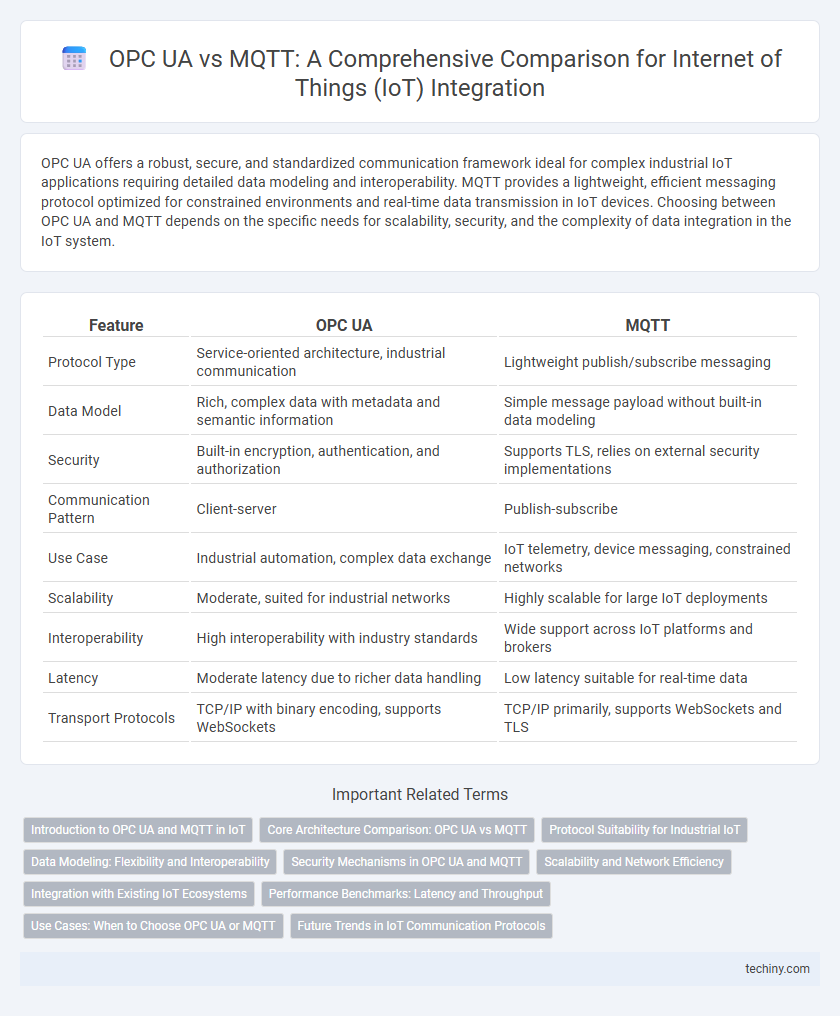OPC UA offers a robust, secure, and standardized communication framework ideal for complex industrial IoT applications requiring detailed data modeling and interoperability. MQTT provides a lightweight, efficient messaging protocol optimized for constrained environments and real-time data transmission in IoT devices. Choosing between OPC UA and MQTT depends on the specific needs for scalability, security, and the complexity of data integration in the IoT system.
Table of Comparison
| Feature | OPC UA | MQTT |
|---|---|---|
| Protocol Type | Service-oriented architecture, industrial communication | Lightweight publish/subscribe messaging |
| Data Model | Rich, complex data with metadata and semantic information | Simple message payload without built-in data modeling |
| Security | Built-in encryption, authentication, and authorization | Supports TLS, relies on external security implementations |
| Communication Pattern | Client-server | Publish-subscribe |
| Use Case | Industrial automation, complex data exchange | IoT telemetry, device messaging, constrained networks |
| Scalability | Moderate, suited for industrial networks | Highly scalable for large IoT deployments |
| Interoperability | High interoperability with industry standards | Wide support across IoT platforms and brokers |
| Latency | Moderate latency due to richer data handling | Low latency suitable for real-time data |
| Transport Protocols | TCP/IP with binary encoding, supports WebSockets | TCP/IP primarily, supports WebSockets and TLS |
Introduction to OPC UA and MQTT in IoT
OPC UA and MQTT are key protocols in the Internet of Things, enabling seamless communication between devices and systems. OPC UA provides a robust, platform-independent framework with built-in security, ideal for industrial automation and complex data models. MQTT offers a lightweight, publish-subscribe messaging pattern designed for low-bandwidth, high-latency environments, making it suitable for constrained IoT devices and real-time telemetry.
Core Architecture Comparison: OPC UA vs MQTT
OPC UA features a service-oriented architecture with a robust, standardized information model enabling complex data representation and secure, reliable communication through built-in security mechanisms like encryption and authentication. MQTT employs a lightweight, publish-subscribe messaging protocol designed for minimal bandwidth and resource consumption, prioritizing simplicity and low latency in constrained IoT environments. Unlike MQTT's broker-dependent model, OPC UA supports both client-server and publish-subscribe communication patterns, providing greater architectural flexibility for industrial automation and complex data exchanges.
Protocol Suitability for Industrial IoT
OPC UA excels in industrial IoT environments by offering secure, reliable, and standardized communication with robust data modeling capabilities critical for complex manufacturing processes. MQTT provides lightweight, efficient messaging optimized for bandwidth-constrained networks, making it ideal for sensor-to-cloud data transmission in resource-limited applications. Selecting between OPC UA and MQTT depends on the need for rich semantic interoperability and security versus low-overhead, high-frequency telemetry data exchange.
Data Modeling: Flexibility and Interoperability
OPC UA provides advanced data modeling capabilities with a rich information model supporting complex data types, namespaces, and semantic relationships, enabling high flexibility and enhanced interoperability across diverse industrial systems. In contrast, MQTT is a lightweight messaging protocol primarily designed for simple publish-subscribe communication without inherent data modeling features, requiring external standards for structured data representation. OPC UA's integrated approach facilitates seamless integration and consistent understanding of device data in complex IoT environments.
Security Mechanisms in OPC UA and MQTT
OPC UA employs robust security mechanisms including end-to-end encryption with AES and RSA, mutual authentication through X.509 certificates, and message integrity ensured by digital signatures. MQTT's security relies primarily on TLS encryption and username/password authentication, but it lacks built-in support for message signing or advanced certificate management. OPC UA's comprehensive security framework makes it more suited for industrial IoT environments requiring stringent protection against cyber threats.
Scalability and Network Efficiency
OPC UA offers robust scalability through its unified architecture and built-in support for complex data models, making it ideal for large industrial IoT deployments. MQTT excels in network efficiency with its lightweight publish-subscribe protocol, minimizing bandwidth usage and ensuring reliable message delivery over constrained networks. Choosing between OPC UA and MQTT depends on the specific requirements for scalability and network efficiency in the IoT environment.
Integration with Existing IoT Ecosystems
OPC UA excels in seamless integration with complex industrial IoT ecosystems due to its standardized information modeling and built-in security features, enabling interoperability across diverse devices and systems. MQTT offers lightweight, publish-subscribe messaging optimized for constrained networks, making it ideal for simple sensor data transmission but requiring additional layers for full semantic interoperability. Combining OPC UA's rich data modeling with MQTT's efficient transport protocols often enhances integration flexibility in heterogeneous IoT deployments.
Performance Benchmarks: Latency and Throughput
OPC UA and MQTT exhibit distinct performance benchmarks in the Internet of Things domain, with MQTT typically offering lower latency and higher throughput due to its lightweight publish-subscribe model designed for constrained environments. OPC UA, while providing robust security and rich data modeling, generally incurs higher latency and reduced throughput compared to MQTT, attributed to its complex protocol stack and server-client architecture. Performance evaluations reveal MQTT excels in real-time sensor data transmission, whereas OPC UA is preferable for applications requiring detailed data context and reliability.
Use Cases: When to Choose OPC UA or MQTT
OPC UA is ideal for industrial automation applications requiring robust data modeling, secure communication, and complex information exchange between devices and control systems. MQTT excels in lightweight, low-bandwidth IoT environments such as smart homes or remote sensor networks where minimal overhead and real-time messaging are crucial. Selecting OPC UA benefits scenarios needing standardized interoperability and built-in security, while MQTT suits extensive, low-resource deployments demanding efficient telemetry and event-driven communication.
Future Trends in IoT Communication Protocols
OPC UA is evolving with enhanced security features and semantic interoperability, making it ideal for complex industrial IoT environments requiring standardized data models. MQTT remains favored for lightweight, low-bandwidth applications due to its simplicity and reliable publish-subscribe messaging. Future IoT communication protocols will likely integrate OPC UA's robust data modeling with MQTT's efficiency to support scalable, secure, and real-time device connectivity.
OPC UA vs MQTT Infographic

 techiny.com
techiny.com